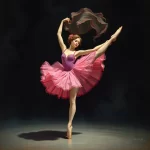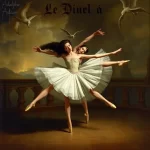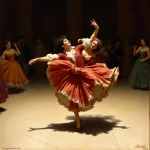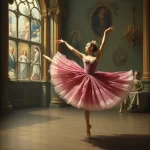Ballet: Le Spectre de la Rose (Carl Maria von Weber, 1911)

Introduction
Le Spectre de la Rose is a one-act ballet that premiered in 1911, choreographed by Michel Fokine and set to the music of Carl Maria von Weber. The ballet is a poetic and ethereal work that captures the fleeting beauty of a dream. It tells the story of a young girl who dreams of dancing with the spirit of a rose she received at her first ball. The ballet is renowned for its delicate choreography and the evocative music that accompanies it.
Historical Background
Creation and Development
The early 20th century was a period of significant transformation in the world of ballet. The Ballets Russes, founded by Sergei Diaghilev, was at the forefront of this change, pushing the boundaries of traditional ballet and incorporating modernist elements. Le Spectre de la Rose was created in this context, reflecting the era’s fascination with symbolism, dreams, and the subconscious.
The ballet was inspired by a poem by Théophile Gautier, which tells the story of a young girl who dreams of a rose’s spirit. Michel Fokine, the choreographer, was deeply influenced by the Symbolist movement and sought to create a ballet that was both visually and emotionally evocative. The collaboration between Fokine and Carl Maria von Weber, whose music was adapted for the ballet, was crucial in bringing this vision to life.
Premiere and Reception
Le Spectre de la Rose premiered on April 19, 1911, at the Théâtre de Monte-Carlo. The initial reception was overwhelmingly positive, with critics and audiences alike praising the ballet’s innovative choreography and the haunting beauty of Weber’s music. The performance featured Vaslav Nijinsky as the Spectre and Tamara Karsavina as the Young Girl, both of whom received acclaim for their roles.
The ballet quickly became a staple of the Ballets Russes repertoire and was revived numerous times in the following years. Its success helped to solidify the reputation of the Ballets Russes as a leading force in the world of dance.
Synopsis of the Ballet
Le Spectre de la Rose is a one-act ballet that unfolds in a single, dreamlike sequence. The story begins with a young girl returning home from her first ball, holding a rose she received as a gift. As she falls asleep, the spirit of the rose appears and dances with her, embodying the beauty and romance of her dream. The ballet concludes with the Spectre disappearing as the girl awakens, leaving her with a lingering sense of wonder and enchantment.
Key Moments
- The Young Girl’s Entrance: The ballet opens with the young girl entering her room, holding the rose and reminiscing about the ball.
- The Spectre’s Appearance: As the girl falls asleep, the spirit of the rose appears, symbolizing the dreamlike quality of the ballet.
- The Pas de Deux: The central dance between the Spectre and the young girl is a highlight of the ballet, showcasing the ethereal choreography and the emotional connection between the characters.
- The Spectre’s Departure: The ballet concludes with the Spectre disappearing as the girl awakens, leaving her with a sense of longing and wonder.
Musical Composition
Composer’s Role
Carl Maria von Weber, a prominent composer of the Romantic era, provided the music for Le Spectre de la Rose. The ballet’s score is adapted from Weber’s piano piece “Invitation to the Dance,” which was orchestrated by Hector Berlioz. Weber’s music is characterized by its lyrical melodies and rich harmonies, which perfectly complement the dreamlike quality of the ballet.
Musical Themes and Motifs
The music of Le Spectre de la Rose features several recurring themes and motifs that enhance the narrative and emotional depth of the ballet. The central theme, which represents the spirit of the rose, is a delicate and haunting melody that recurs throughout the ballet. This theme is often accompanied by lush orchestration, creating a sense of enchantment and wonder.
The music also features contrasting sections that reflect the different moods and emotions of the ballet. For example, the lively and playful sections of the score correspond to the joyous moments of the dance, while the more introspective passages underscore the dreamlike and ephemeral nature of the story.
Famous Recordings and Performances
Several iconic recordings of the ballet’s music have been made over the years, featuring renowned orchestras and conductors. Notable performances include those by the London Symphony Orchestra conducted by Sir Colin Davis and the Berlin Philharmonic conducted by Herbert von Karajan. These recordings capture the beauty and nuance of Weber’s score, bringing the music of Le Spectre de la Rose to life for audiences around the world.
Choreography and Dance
Choreographer’s Vision
Michel Fokine’s choreography for Le Spectre de la Rose is a masterful blend of classical ballet technique and modernist innovation. Fokine sought to create a ballet that was both visually stunning and emotionally resonant, using fluid and expressive movements to convey the dreamlike quality of the story. His choreography emphasizes the ethereal nature of the Spectre, with light and airy jumps and turns that give the impression of weightlessness.
Signature Dance Numbers
The central dance of Le Spectre de la Rose is the pas de deux between the Spectre and the young girl. This dance is a highlight of the ballet, showcasing the delicate and intricate choreography that Fokine is known for. The pas de deux features a series of lifts, turns, and jumps that create a sense of fluidity and grace, reflecting the romantic and dreamlike nature of the story.
Another key moment in the ballet is the Spectre’s solo dance, which highlights the character’s ethereal and otherworldly qualities. This solo is characterized by its light and airy movements, with the dancer appearing to float across the stage.
Notable Interpretations
Over the years, Le Spectre de la Rose has been interpreted and adapted by various choreographers and dance companies. Each production brings its own unique perspective to the ballet, while staying true to Fokine’s original vision. Notable interpretations include those by Rudolf Nureyev, who brought a more dramatic and intense quality to the role of the Spectre, and Mikhail Baryshnikov, whose performance emphasized the character’s grace and elegance.
Characters and Roles
Main Characters
- The Spectre of the Rose: The spirit of the rose, who appears in the young girl’s dream. The Spectre is characterized by his ethereal and otherworldly qualities, and his dance is marked by light and airy movements.
- The Young Girl: The protagonist of the ballet, who dreams of dancing with the spirit of the rose. The young girl’s character is defined by her innocence and sense of wonder.
Supporting Characters
As a one-act ballet with a focused narrative, Le Spectre de la Rose primarily features the two main characters. However, the ballet’s ensemble plays a crucial role in creating the dreamlike atmosphere and supporting the central dance sequences.
Famous Dancers
Several renowned dancers have portrayed the roles of the Spectre and the young girl over the years. Vaslav Nijinsky, who originated the role of the Spectre, is perhaps the most famous, known for his incredible athleticism and expressive performance. Other notable dancers include Rudolf Nureyev, Mikhail Baryshnikov, and Tamara Karsavina, who brought their own unique interpretations to the roles.
Cultural and Artistic Impact
Influence on Ballet and Dance
Le Spectre de la Rose has had a significant impact on the world of ballet and dance. Its innovative choreography and evocative music have inspired countless choreographers and dancers, and its success helped to establish the Ballets Russes as a leading force in the world of dance. The ballet’s emphasis on fluidity and expressiveness has influenced the development of modern ballet, and its dreamlike quality has inspired other works that explore similar themes.
Cultural Significance
The ballet’s place in popular culture is also noteworthy. Le Spectre de la Rose has been referenced in literature, film, and other media, and its iconic imagery has become a symbol of romanticism and beauty. The ballet’s themes of dreams and the subconscious have resonated with audiences for over a century, making it a timeless work that continues to captivate and inspire.
Legacy and Revivals
Le Spectre de la Rose has been revived numerous times since its premiere, with each production bringing new life to the ballet. Major revivals have been staged by leading dance companies around the world, including the Royal Ballet, the Paris Opera Ballet, and the American Ballet Theatre. These revivals have helped to keep the ballet’s legacy alive, ensuring that it continues to be performed and celebrated by new generations of dancers and audiences.
Iconic Productions
Historic Productions
Some of the most famous historical productions of Le Spectre de la Rose include the original 1911 premiere by the Ballets Russes, featuring Vaslav Nijinsky and Tamara Karsavina. This production is considered a landmark in the history of ballet, and its success helped to establish the Ballets Russes as a leading force in the world of dance.
Contemporary Productions
Recent productions of Le Spectre de la Rose have brought new interpretations and innovations to the ballet. Contemporary choreographers have explored different aspects of the story and characters, while staying true to Fokine’s original vision. These productions often feature updated set and costume designs, as well as new interpretations of the choreography.
Production Design
The set, costume, and lighting design of Le Spectre de la Rose play a crucial role in creating the ballet’s dreamlike atmosphere. Traditional productions often feature elaborate and romantic set designs, with soft lighting and delicate costumes that enhance the ethereal quality of the ballet. Contemporary productions may experiment with more minimalist or abstract designs, bringing a fresh perspective to the ballet while maintaining its core themes.
Critical Reception and Reviews
Initial Critical Response
The initial critical response to Le Spectre de la Rose was overwhelmingly positive. Critics praised the ballet’s innovative choreography, evocative music, and the performances of Nijinsky and Karsavina. The ballet was seen as a groundbreaking work that pushed the boundaries of traditional ballet and introduced new elements of modernism and symbolism.
Modern Reviews
Contemporary critics and audiences continue to hold Le Spectre de la Rose in high regard. The ballet is celebrated for its timeless beauty and emotional depth, and its themes of dreams and the subconscious remain relevant to modern audiences. Critics often highlight the ballet’s innovative choreography and the evocative power of Weber’s music, as well as the enduring appeal of its central pas de deux.
Fun Facts and Trivia
Behind-the-Scenes Stories
One interesting anecdote from the original production of Le Spectre de la Rose involves Vaslav Nijinsky’s famous leap through a window at the end of the ballet. This dramatic exit became one of the most iconic moments in ballet history, and Nijinsky’s incredible athleticism and grace left audiences in awe.
Notable Performers
In addition to Nijinsky and Karsavina, other famous dancers who have performed in Le Spectre de la Rose include Rudolf Nureyev, Mikhail Baryshnikov, and Margot Fonteyn. Each of these dancers brought their own unique style and interpretation to the roles, contributing to the ballet’s enduring legacy.
Trivia
- The ballet’s title, Le Spectre de la Rose, translates to “The Spirit of the Rose” in English.
- The original poem by Théophile Gautier that inspired the ballet was written in 1837.
- The ballet’s score, “Invitation to the Dance,” was originally composed by Carl Maria von Weber as a piano piece in 1819 and later orchestrated by Hector Berlioz.
Conclusion
Summary of the Ballet’s Importance
Le Spectre de la Rose is a significant work in the world of ballet, known for its innovative choreography, evocative music, and timeless themes. The ballet’s success helped to establish the Ballets Russes as a leading force in dance and influenced the development of modern ballet. Its dreamlike quality and emotional depth continue to captivate audiences and inspire new generations of dancers and choreographers.
Final Thoughts
Le Spectre de la Rose remains a beloved and celebrated work in the world of ballet. Its themes of dreams and the subconscious resonate with audiences of all ages, and its innovative choreography and evocative music continue to inspire and enchant. Whether you are a seasoned ballet enthusiast or a newcomer to the art form, Le Spectre de la Rose is a must-see performance that captures the beauty and magic of dance.
FAQ
What is the central theme of this ballet?
The central theme of Le Spectre de la Rose is the fleeting beauty of dreams and the ephemeral nature of romance.
Who are the main characters in this ballet?
The main characters are the Spectre of the Rose and the Young Girl.
What is the most famous dance number in this ballet?
The most famous dance number is the pas de deux between the Spectre and the Young Girl.
How long does a typical performance of this ballet last?
A typical performance of Le Spectre de la Rose lasts approximately 10-15 minutes.
Are there any modern adaptations of this ballet?
Yes, there have been several modern adaptations and reinterpretations of Le Spectre de la Rose, each bringing new perspectives to the ballet while staying true to its original themes.
Why is this ballet considered important in the history of dance?
Le Spectre de la Rose is considered important because of its innovative choreography, evocative music, and its role in establishing the Ballets Russes as a leading force in the world of dance. Its influence on modern ballet and its timeless themes continue to resonate with audiences today.





